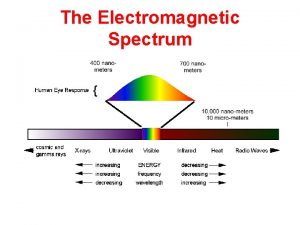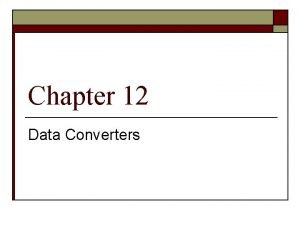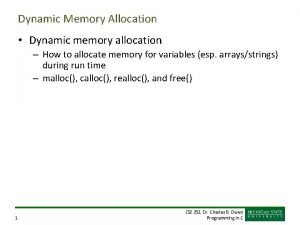Dynamic Wavelength Allocation and Wavelength Conversion Wavelength Converters



















- Slides: 19

Dynamic Wavelength Allocation and Wavelength Conversion

Wavelength Converters • A wavelength converter is modeled by a bipartite graph. • For any two adjacent edges x, y, we define the corresponding conversion graph Gxy=(Vx, Vy, Exy) where: • Vx={x 0, x 1, …x. W-1} • Vy={y 0, y 1, …y. W-1} • if and only if wavelength i on endpoint x can be converted to wavelength j on endpoint y (i is compatible with j on x-y ).

Wavelength Converters • A wavelength converter is symmetric if: • A full wavelength converter corresponds to a complete bipartite graph. • The degree of a wavelength converter is the maximum degree of a node in the bipartite graph.

Full Wavelength Converters • Any instance can be colored using W=L wavelengths. (In fact we need only d>=L) • Proof: – Given a path , we can color its edges independently of each other, because the full conversion capability. – Consider any edge : There at most L 1 paths other than p traversing this edge. They use at most L-1=W-1 colors. We can use any one from the remaining colors for p.

Expander Graphs • Definition: Given any , we define the neighborhood of S, namely: • Definition: A bipartite graph (V 1, V 2, E) is an (a, b, d)-expander if: – each node has degree at most d. – 0<a<½ –b>1 – for any ,

Expander Graphs • Lemma: There is a triple (a, b, d), such that: for every sufficiently large n, there is an (a, b, d)-expander with n nodes.

Limited Wavelength Converters (Any Graph) • Theorem: There exists two constants k>1 and d>1, such that every instance can be colored with – W=k. L colors – Using wavelength converters with degree d. • Proof: Between each two adjacent edges we use the converter which correspond to the (a, b, d)expander whose existence is guaranteed by the previous lemma. • Let k=1/min{a(b-1), 1 -a} • We will prove that as long as L <= W min{a(b 1), 1 -a}, any path can be colored.

Limited Wavelength Converters (Any Graph) • Assume L <= W a(b-1) and L<=W(1 -a) • Consider a path p=(e 1, e 2, …, el) to be colored. • For any edge e 1, e 2, …, el a color is said to be busy if it is used by another path. • For any edge ei, (i>1) a color c is said to be busy also if all the colors compatible with c are busy in ei-1

Limited Wavelength Converters (Any Graph) • Claim: There a. W colors which are not busy (idle) in ei. (By induction on i) – i=1: L<=W(1 -a), therefore there a. W colors idle in e 1. – i > 1: • In edge ei+1 there at least ba. W colors compatible with the idle colors of ei • At most L<W a(b-1) of them are used by other lightpaths. • We are left with at least ba. W- Wa(b-1)= a W idle colors.

Limited Wavelength Converters (Rings) • Theorem: Any instance of ring graph can be colored with – W=L log L + 4 L colors (independent of N !!) – using converters of degree 2. • Proof: – Divide the ring into segments of length at least L, but less than 2 L. • Wline(N, L)<=L log N (prove) • Wline(2 L, L)<=L log N + L • We can color the intra-segment paths with L log. N + L colors with no wavelength conversion.

Limited Wavelength Converters (Rings) – Use the following graph to color inter-segment paths: • An edge of the graph is a color. • A vertex joins compatible colors. u 1 u 2 u. L v 1 v 2 v. L First segment Intermediate segment Last segment

Incremental WLA in Rings • Claim: Any instance in Ring graphs can be colored using W <= max{L, 2 L-d}colors. • Algorithm: – Initialization: • • • M = max {0, L-d} for i=0 to M do POOL(0)={1, …, min{L, d}} w=d for i=1 to M do POOL(i)={++w, ++w}

Incremental WLA in Rings Notation: • l(e/S) -Load induced on edge e by paths in S, namely: • Note that l(e)=l(e/P). • • Fi the set of paths received before path i, namely: Fi={p 1, p 2, …, pi-1}

Incremental WLA in Rings • Algorithm (path p) – i=0; – While L(p/Si) >= d+i do i++ – – Color the edges of p using wavelengths from SHELF(i)

Incremental WLA in Rings Lemma: Let then Proof: Assume and , therefore contradicting to the fact that .

Incremental WLA in Rings Lemma: Let then Proof: w. l. o. g. x<y. • Assume , then by previous lemma The algorithm would place py in SHELF(j) for some j<i.

Incremental WLA in Rings • Assume , therefore The algorithm would place py in SHELF(j) for some j>i.

Incremental WLA in Rings • The maximum load induced by the paths of SHELF(0) is d. By code inspection. • The maximum load induced by the paths of SHELF(i) (i>0) is 2. – Assume otherwise. There is an edge with three paths traversing it. By previous lemma, none of them contains the other. W. l. o. g assume they are sorted by their starting points:

Incremental WLA in Rings By the above picture, for any set S of paths: By the first lemma: Load is non decreasing: Combining, we get: The algorithm would place py in SHELF(j) for some j<i.
 Linked allocation
Linked allocation Longest to shortest wavelength
Longest to shortest wavelength Dynamic p table
Dynamic p table Dcac converters
Dcac converters Flash adc advantages and disadvantages
Flash adc advantages and disadvantages Redox reaction in catalytic converters
Redox reaction in catalytic converters Flyback converter
Flyback converter Dcac converters
Dcac converters Digital to analog converters basic concepts
Digital to analog converters basic concepts Eme converter
Eme converter A dual converters has
A dual converters has Multiple output flyback converter
Multiple output flyback converter Intelligent converters
Intelligent converters Dynamic strategies for asset allocation
Dynamic strategies for asset allocation What is dynamic storage-allocation problem
What is dynamic storage-allocation problem Example of dynamic memory allocation
Example of dynamic memory allocation Knuth's boundary tags
Knuth's boundary tags Dynamic memory allocation
Dynamic memory allocation Example of dynamic memory allocation
Example of dynamic memory allocation Dynamic memory allocation in data structure
Dynamic memory allocation in data structure



































